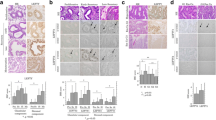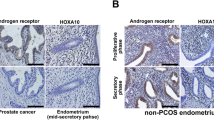Abstract
Polycystic ovarian syndrome (PCOS) has been associated with endometrial hyperplasia and cancer. The aim of this study was to establish whether the expression of proliferation regulatory proteins in the endometria of patients having PCOS, with or without hyperplasia, differs from control women. Control endometria (CE), patients having PCOS without and with endometrial hyperplasia (PCOSE and HPCOSE, respectively), and that of women with endometrial hyperplasia (HE) were used. The phosphorylated estrogen receptor form (pERα), similar to mother against decapentaplegic (SMAD) 2, SMAD3, and SMAD4, vascular epithelial growth factor (VEGF), and phosphorylated SMAD (pSMAD) 2 and pSMAD3 were detected by immunohistochemistry or Western blot. The results show higher levels of pERα in HE versus CE (P < .05), while higher VEGF levels were found in PCOSE and HE (P < .05) compared to CE; SMAD2 diminished in HE (P < .05) versus CE. Consequently, the higher levels of VEGF and pERα in PCOSE could represent early changes in the progression of PCOSE toward hyperplasia and cancer, whereas changes observed in SMAD proteins support the differential origin of the pathologies of HPCOSE and HE.
Similar content being viewed by others
References
Salley KES, Wickham EP, Cheang KI, Essah PA, Karjane NW, Nestler JE. Position statement: glucose intolerance in polycystic ovary syndrome-a position statement of the androgen excess society. J Clin Endocrinol Metab. 2007;92(12):4546–4556.
Okoroh EM, Hooper WC, Atrash HK, Yusuf HR, Boulet SL. Prevalence of polycystic ovary syndrome among the privately insured, United States, 2003– 2008. Am J Obstet Gynecol. 2012;207(4):1–7.
Gabrielli L, Aquino EML. Polycystic ovary syndrome in Salvador, Brazil: a prevalence study in primary healthcare. Reprod biol endocrinol. 2012;10:96.
Giudice LC.Endometrium in PCOS: Implantation and predisposition to endocrine CA. Best Pract Res Clin Endocrinol Metab. 2006;20(2):235–44.
Ehrmann DA. Polycystic ovary syndrome. New Engl J Med. 2005;352(12):1223–1236.
Fearnley EJ, Marquart L, Spurdle AB, Weinstein P, Webb PM. The Australian ovarian cancer study group and the Australian National Endometrial Cancer Study Group. Polycystic ovary syndrome increases the risk of endometrial cancer in women aged less than 50 years: an Australian case–control study. Cancer Causes Control. 2010;21(12):2303–2308.
Kilicdag EB, Haydardedeoglu B, Cok T, Parlakgumus AH, Simsek E, Bolat FA. Polycystic ovary syndrome and increased polyp numbers as risk factors for malignant transformation of endometrial polyps in premenopausal women. Int J Gynecol Obstet. 2011;112(3):200–203.
Avellaira C, Villavicencio A, Bacallao K, et al. Expression of molecules associated with tissue homeostasis in secretory endometria from untreated women with polycystic ovary syndrome. Hum Reprod. 2006;21(3):3116–3121.
Villavicencio A, Bacallao K, Gabler F, et al. Deregulation of tissue homeostasis in endometria from patients with polycystic ovarian syndrome with and without endometrial hyperplasia. Gynecol Oncol. 2007;104(2):290–295.
Giudice LC. Elucidating endometrial function in the post-genomic era. Hum Reprod Update. 2003;9(3):223–235.
Groothuis PG, Dassen HH, Romano A, Punyadeera C. Estrogen and the endometrium: lessons learned from gene expression profiling in rodents and human. Hum Reprod Update 2007;13(4):405–417.
Gregory CW, Wilson EM, Apparao KB, et al. Steroid receptor coactivator expression throughout the menstrual cycle in normal and abnormal endometrium. J Clin Endocrinol Metabol. 2002; 87(6):2960–2966.
Quezada S, Avellaira C, Johnson MC, Gabler F, Fuentes A, Vega M. Evaluation of steroid receptors, coregulators, and molecules associated with uterine receptivity in secretory endometria from untreated women with polycystic ovary syndrome. Fertil Steril. 2006;85(4):1017–1026.
Villavicencio A, Bacallao K, Avellaira C, Gabler F, Fuentes A, Vega M. Androgen and estrogen receptors and co-regulators levels in endometria from patients with polycystic ovarian syndrome with and without endometrial hyperplasia. Gynecol Oncol. 2006;103(1):307–314.
Plaza-Parrochia F, Bacallao K, Poblete C, et al. The role of androst-5-ene-3β,17β-diol (androstenediol) in cell proliferation in endometrium of women with polycystic ovary syndrome. Steroids. 2014;89:11–19.
Lannigan DA. Estrogen receptor phosphorylation. Steroids. 2003; 68(1):1–9.
Lipfert L, Fisher JE, Wei N, et al. Antagonist-induced, activation function-2-independent estrogen receptor phosphorylation. Mol Endocrinol. 2006;20(3):516–533.
Strissel PL, Ellmann S, Loprich E, et al. Early aberrant insulin-like growth factor signaling in the progression to endometrial carcinoma is augmented by tamoxifen. Int J Cancer. 2008;123(12):2871–2879.
Murphy LC, Weitsman GE, Skliris GP, et al. Potential role of estrogen receptor a (ERa) phosphorylated at Serine 118 in human breast cancer in vivo. J Steroid Biochem Mol Biol. 2006;102(1–5):139–146.
Perrot-Applanat M, Di Benedetto M. Autocrine functions of VEGF in breast tumor cells adhesion, survival, migration and invasion. Cell Adh Migr. 2012;6(6):547–553.
Tomao F, Papa A, Rossi L, et al. Angiogenesis and antiangiogenic agents in cervical cancer. Onco Targets Ther. 2014;7:2237–2248.
Moustakas A, Souchelnytskyi S, Heldin CH. Smad regulation in TGF-β signal transduction. J Cell Sci. 2001;114(pt 24):4359–4369.
Parekh TV, Gama P, Wen X, et al. Transforming growth factor b signalling is disabled early in human endometrial carcinogenesis concomitant with loss of growth inhibition. Cancer Res. 2002; 62(10):2778–2790.
Sakaguchi J, Kyo S, Kanaya T, et al. Aberrant expression and mutations of TGF-h receptor type II gene in endometrial cancer. Gynecol Oncol. 2005;98(3):427–433.
Goto N, Hiyoshi H, Ito I, Tsuchiya M, Nakajima Y, Yanagisawa J. Estrogen and antiestrogens alter breast cancer invasiveness by modulating the transforming growth factor-b signaling pathway. Cancer Sci. 2011;102(8):1501–1508.
Chen C, Sun MZ, Liu S, et al. Smad4 mediates malignant behaviors of human ovarian carcinoma cell through the effect on expressions of E-cadherin, plasminogen activator inhibitor1 and VEGF. BMB Rep. 2010;43(8):55460.
Rötterdam ESHRE/ASRM-Sponsored PCOS Consensus Workshop Group. Revised 2003 consensus on diagnostic criteria and long-term health risks related to polycystic ovary syndrome. Fertil Steril. 2004;81(1):19–25.
Noyes RW, Hertig AT, Rock J. Dating the endometrial biopsy. Am J Obstet Gynecol. 1975;122(2):262–263.
Kurman RJ, Kaminski PF, Norris HJ. The behavior of endometrial hyperplasia. A long term study of “untreated” hyperplasia in 170 patients. Cancer. 1985;56(2):403–412.
Carvajal R, Rosas C, Kohan K, et al. Metformin augments the levels of molecules that regulate the expression of the insulin-dependent glucose transporter GLUT4 in the endometria of hyper-insulinemic PCOS patients. Hum Reprod. 2013;28(8):2235–2244.
Villavicencio A, Goyeneche A, Telleria C, et al. Involvement of Akt, Ras and cell cycle regulators in the potential development of endometrial hyperplasia in women with polycystic ovarian syndrome. Gynecol Oncol. 2009;115(1):102–107.
Plaza F, Gabler F, Romero C, Vantman D, Valladares L, Vega M. The conversion of dehydroepiandrosterone into androst-5-ene-3β,17β-diol (androstenediol) is increased in endometria from untreated women with polycystic ovarian syndrome. Steroids. 2010;75(12):810–817.
Schulte MMB, Tsai JH, Moley KH. Obesity and PCOS: The Effect of Metabolic Derangements on Endometrial Receptivity at the Time of Implantation. Reprod Sci. 2015;22(1):6–14.
Maofu F, Wang C, Zhang X, Pestell R. Nuclear receptor modification and endocrine cell proliferation. J Steroid Biochem Mol Biol. 2003;85(2–5):133–138.
Shupnik MA. Crosstalk between steroid receptors and the c-Src-receptor tyrosine kinase pathways: implications for cell proliferation. Oncogene. 2004;23(48):7979–7989.
Miller KKM, Al-Rayyan N, Ivanova MM, et al. DHEA metabolites activate estrogen receptors alpha and beta. Steroids. 2013; 78(1):15–25.
Baker ME, Uhb KY, Chandsawangbhuwana C. 3D models of human ERα and ERβ complexed with 5-androsten-3β,17β-diol. Steroids. 2012;77(12):1192–1197.
Lasley BL, Chen J, Stanczyk FZ, et al. Androstenediol complements estrogenic bioactivity during the menopausal transition. Menopause. 2012;19(6):650–657.
Pestell RG, Albanese C, Reutens AT, Segall JE, Lee RJ, Arnold A. The cyclins and cyclin dependent kinase inhibitors in hormonal regulation of proliferation and differentiation. Endocr Rev. 1999; 20(4):501–534.
Claesson-Welsh L, Welsh M. VEGFA and tumour angiogenesis. J Intern Med. 2013;273(2):114–127.
Hyder SM. Sex-steroid regulation of vascular endothelial growth factor in breast cancer. Endocrine-Related Cancer. 2006;13(3): 667–687.
Piestrzeniewicz-Ulanska D, Brys M, Semczuk A, Jakowicki JA, Krajewska WM. Expression and intracellular localization of Smad proteins in human endometrial cancer. Oncol Rep. 2003; 10(5):1539–1544.
Piestrzeniewicz-Ulanska D, Brys M, Semczuk A, Rechberger T, Jakowicki JA, Krajewska WM. TGF-β signaling is disrupted in endometrioid-type endometrial carcinomas. Gynecol Oncol. 2004;95(1):173–180.
Derynck R, Akhurst RJ, Balmain A. TGF-beta signaling in tumor suppression and cancer progression. Nat Genet. 2001;29(2):117–129.
Massague J, Gomis RR. The logic of TGF beta signalling. FEBS Lett. 2006;580(12):2811–2820.
Gold LI, Saxena B, Mittal KR, et al. Increased expression of transforming growth factor beta isoforms and basic fibroblast growth factor in complex hyperplasia and adenocarcinoma of the endometrium: evidence for paracrine and autocrine action. Cancer Res. 1994;54(9):2347–2358.
Chiappini F, Pontillo C, Randi A, Alvarez L, Kleiman de Pisarev DL. Hexachlorobenzene induces TGF-b1 expression, which is a regulator of p27 and cyclin D1 modifications. Toxicol Lett. 2014;230(1):1–9.
Van der Poel HG. Androgen receptor and TGFbeta1/Smad signaling are mutually inhibitory in prostate cancer. Eur Urol. 2005; 48(6):1051–1058.
Malkoski SP, Wang XJ. Two sides of the story? Smad4 loss in pancreatic cancer versus head-and-neck cancer. FEBS Lett. 2012;586(14):1984–1992.
Author information
Authors and Affiliations
Corresponding author
Rights and permissions
About this article
Cite this article
Bacallao, K., Plaza-Parrochia, F., Cerda, A. et al. Levels of Regulatory Proteins Associated With Cell Proliferation in Endometria From Untreated Patients Having Polycystic Ovarian Syndrome With and Without Endometrial Hyperplasia. Reprod. Sci. 23, 211–218 (2016). https://doi.org/10.1177/1933719115597762
Published:
Issue Date:
DOI: https://doi.org/10.1177/1933719115597762




